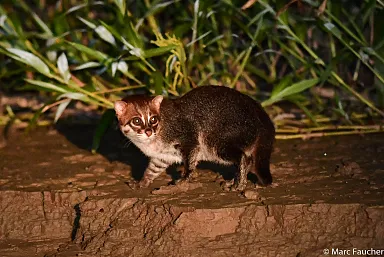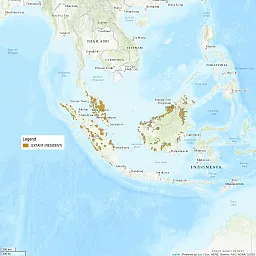
Flat headed cat photo © Marc Faucher / pfaucher · some rights reserved
Flat-headed Cat
Species Facts
The flat-headed cat can look you straight in the eye, if you ever have the fortune to see one. Its eyes are set farther forward and closer together than those of other cats, giving it exceptional stereoscopic vision.
- Scientific Designation: Prionailurus planiceps
- Endangered Status: Endangered (EN)
- Lifespan: Over 14 years
- Weight: 1.5-2.5 kg
- Length: 53-81cm
- Height: 33-50 cm
Profile
A peculiar looking cat with short legs, a long head with tiny, low-set ears, and a short tail, the flat-headed cat has long, thick, and soft fur. The color of the fur is reddish brown on top of the head, dark roan brown on the body, and mottled white on the underbelly. The muzzle and chin are white.
The flat-headed cat’s diet is dominated by fish, so it usually stays close to water. The species’ prey also includes frogs and shrimp. Rodents and domestic chicken are also taken at times. Flat-headed cats also consume fruit and sweet potatoes, the latter from plantations.

Species Distribution
The flat-headed cat’s range includes southern Thailand, Malaysia, Sumatra, and Borneo. Within this range, this cat inhabits forests along rivers and streams. The cat presumably is solitary, and like other cats, maintains its range by scent marking. However, as is the case with many wild cats, not much is known about the species. All available information comes from five to six animals in captivity and fewer than 20 specimens collected in the wild.
Distribution map courtesy of IUCN (International Union for Conservation of Nature), compiled in 2015.
Threats to the Flat-headed Cat
This rare and elusive cat is threatened with water pollution, especially from oil, organochlorines, and heavy metals found in run-off from agricultural and logging activities. The cats are poisoned after these contaminates have been ingested by its prey. The clearance of waterways as human settlement expands into forested areas is also a problem for this species. Currently, the flat-headed cat is classified as Vulnerable (VU) in the International Union for Conservation of Nature (IUCN) Red List, and is protected under appendix I in the Convention on International Trade in Endangered Species (CITES).
Want to help us research and conserve this species?
Felidae Conservation Fund helps researchers around the world study and protect felids of all sizes.
Make sure you write a comment with "Flat-headed Cat" so we can designate 100% of your donation to go to protecting this species.
Do You Have 2-4 Hours A Month To Preserve Your Local Ecosystem?
Our volunteers are the driving force behind making true change in ecosystem health and wild cat conservation. Some like to volunteer in the field, others help us maintain our online presence, and some work with events. With just a few hours a month, you can make a difference, too.
Make A Difference Right Now
As a 501(c)3 nonprofit, our work is only possible because of generous donors like you.
More than 90% of your donation will go directly to our groundbreaking research, outreach, and education programs.
This is where true change starts. If you’d like to be a part of it, make a donation to Felidae Conservation Fund today:
Or,
